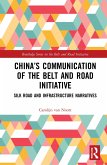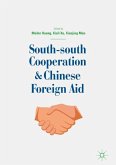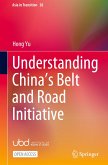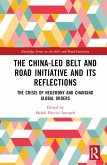Cooperation Between China and Eurasian Countries under the "Belt and Road Initiative" Framework
Herausgegeben:Cui, Zheng; Qu, Wenyi
Versandkostenfrei innerhalb Deutschlands
106,99 €
inkl. MwSt.
Versandkostenfrei*
Erscheint vorauss. 1. März 2026
Melden Sie sich
hier
hier
für den Produktalarm an, um über die Verfügbarkeit des Produkts informiert zu werden.

53 °P sammeln
Cooperation Between China and Eurasian Countries under the "Belt and Road Initiative" Framework
Herausgegeben:Cui, Zheng; Qu, Wenyi
- Gebundenes Buch
This book, starting from multiple disciplines and perspectives, combining qualitative and quantitative analysis, examines the cooperation between China and Eurasian countries under the framework of the "Belt and Road Initiative". It covers five topics, namely, policy communication, facilities connection, trade flow, capital circulation and people-to-people interactions. Despite different perspectives and methods, the contributing authors are agreed that the construction of the "Belt and Road" can facilitate the development of all participating countries, even though they will likely also face…mehr
Andere Kunden interessierten sich auch für
![Critical Reflections on China's Belt & Road Initiative Critical Reflections on China's Belt & Road Initiative]() Critical Reflections on China's Belt & Road Initiative76,99 €
Critical Reflections on China's Belt & Road Initiative76,99 €![China's Communication of the Belt and Road Initiative China's Communication of the Belt and Road Initiative]() Carolijn van NoortChina's Communication of the Belt and Road Initiative167,99 €
Carolijn van NoortChina's Communication of the Belt and Road Initiative167,99 €![South-south Cooperation and Chinese Foreign Aid South-south Cooperation and Chinese Foreign Aid]() South-south Cooperation and Chinese Foreign Aid98,99 €
South-south Cooperation and Chinese Foreign Aid98,99 €![Understanding China's Belt and Road Initiative Understanding China's Belt and Road Initiative]() Hong YuUnderstanding China's Belt and Road Initiative39,99 €
Hong YuUnderstanding China's Belt and Road Initiative39,99 €![Understanding China's Belt and Road Initiative Understanding China's Belt and Road Initiative]() Hong YuUnderstanding China's Belt and Road Initiative31,99 €
Hong YuUnderstanding China's Belt and Road Initiative31,99 €![Belt and Road Initiative and the Future of Regional Order in the Indo-Pacific Belt and Road Initiative and the Future of Regional Order in the Indo-Pacific]() Belt and Road Initiative and the Future of Regional Order in the Indo-Pacific44,99 €
Belt and Road Initiative and the Future of Regional Order in the Indo-Pacific44,99 €![The China-led Belt and Road Initiative and its Reflections The China-led Belt and Road Initiative and its Reflections]() The China-led Belt and Road Initiative and its Reflections168,99 €
The China-led Belt and Road Initiative and its Reflections168,99 €-
-
-
This book, starting from multiple disciplines and perspectives, combining qualitative and quantitative analysis, examines the cooperation between China and Eurasian countries under the framework of the "Belt and Road Initiative". It covers five topics, namely, policy communication, facilities connection, trade flow, capital circulation and people-to-people interactions. Despite different perspectives and methods, the contributing authors are agreed that the construction of the "Belt and Road" can facilitate the development of all participating countries, even though they will likely also face problems and risks. The volume provides a balanced analysis of both opportunities and challenges for all stakeholders in this historic undertaking.
Produktdetails
- Produktdetails
- China and Globalization 2.0
- Verlag: Springer, Berlin; Social Sciences Academic Press; Pal
- Artikelnr. des Verlages: 86996204
- Erscheinungstermin: 1. März 2026
- Englisch
- Abmessung: 210mm x 148mm
- ISBN-13: 9789819538973
- ISBN-10: 9819538971
- Artikelnr.: 75500003
- Herstellerkennzeichnung
- Springer-Verlag GmbH
- Tiergartenstr. 17
- 69121 Heidelberg
- ProductSafety@springernature.com
- China and Globalization 2.0
- Verlag: Springer, Berlin; Social Sciences Academic Press; Pal
- Artikelnr. des Verlages: 86996204
- Erscheinungstermin: 1. März 2026
- Englisch
- Abmessung: 210mm x 148mm
- ISBN-13: 9789819538973
- ISBN-10: 9819538971
- Artikelnr.: 75500003
- Herstellerkennzeichnung
- Springer-Verlag GmbH
- Tiergartenstr. 17
- 69121 Heidelberg
- ProductSafety@springernature.com
Zheng Cui, Ph.D. is a professor and doctoral advisor at Liaoning University. Cui s research interests include geopolitical economics and international relations in Eurasia.
Wenyi Qu, Ph.D. is a professor and doctoral advisor at East China Normal University. Qu s research focuses on the Russian and Eurasian economies and China-Russian (Eurasian) economic relations.
Wenyi Qu, Ph.D. is a professor and doctoral advisor at East China Normal University. Qu s research focuses on the Russian and Eurasian economies and China-Russian (Eurasian) economic relations.
.- Part I Economics and Politics in Eurasia.
.- Chapter 1 Putin’s Countermeasures Against the West’s Economic Sanctions
and Their Effects.
.- Chapter 2 Russia’s Economic Prospects from a Structural Perspective.
.- Chapter 3 Far East’s Development Model Under Russia’s “Turn to the East”
Strategy.
.- Chapter 4 Logistics, International Trade, and Tourism in Countries Along
the Silk Road – Path of Development and Status Quo.
.- Part II Alignment Between Belt and Road Initiative and Eurasian Economic
Union.
.- Chapter 5 Connection Between Silk Road Economic Belt and Eurasian
Economic Union.
.- Chapter 6 Risks of Connecting Silk Road Economic Belt with Eurasian
Integration.
.- Chapter 7 Perception of the Connection Between Silk Road Economic Belt
and Eurasian Economic Union – A Study of How Russians View China.
.- Chapter 8 From the Government to the Public – Analysis of Central Asian
Countries’ Perception of China-proposed Belt and Road Initiative.
.- Chapter 9 Greater Eurasia and China-Russia Strategic Partnership.
.- Chapter 10 What the Silk Road Economic Belt Means for Kazakhstan:
Benefits and Prospects.
.- Part III Economic Cooperation under the Framework of Belt and Road
Initiative.
.- Chapter 12 China’s Spillover Effect on Central Asian Countries in the
Context of “Silk Road Economic Belt” — A Simulated Analysis Based on
Dynamic Stochastic General Equilibrium (DSGE) Model.
.- Chapter 13 Key Points in the Study of China-Russia Economic and Trade
Cooperation in the Framework of Belt and Road Initiative.
.- Chapter 14 Political Economics in China-Russia Economic Cooperation and
The Effects on Belt and Road Initiative.
.- Chapter 15 Connection and Cooperation Between Dalian Area of China
(Liaoning) Pilot Free Trade Zone and Free Port of Vladivostok in Russian
Far East.
.- Chapter 16 Russia’s Innovative Development and China-Russia Cooperation
in Innovation.
.- Chapter 17 Potential of Cooperation Between Belarusian and Chinese
Universities in the Geo-economic Context of the Silk Road.
.- Chapter 18 The Model of Financial Cooperation Between China and Belarus
on the Silk Road.
.- Chapter 19 Industrial Coupling and Development Between China and
Kazakhstan in the Context of the Silk Road Economic Belt.
.- Chapter 20 Cooperation Among Belarus, Ukraine and Lithuania Under the
Silk Road Economic Belt Initiative.
.- Chapter 21 Keeping the Integrity of Seamless Transport System in Eurasia
under Belt and Road Initiative.
.- Chapter 1 Putin’s Countermeasures Against the West’s Economic Sanctions
and Their Effects.
.- Chapter 2 Russia’s Economic Prospects from a Structural Perspective.
.- Chapter 3 Far East’s Development Model Under Russia’s “Turn to the East”
Strategy.
.- Chapter 4 Logistics, International Trade, and Tourism in Countries Along
the Silk Road – Path of Development and Status Quo.
.- Part II Alignment Between Belt and Road Initiative and Eurasian Economic
Union.
.- Chapter 5 Connection Between Silk Road Economic Belt and Eurasian
Economic Union.
.- Chapter 6 Risks of Connecting Silk Road Economic Belt with Eurasian
Integration.
.- Chapter 7 Perception of the Connection Between Silk Road Economic Belt
and Eurasian Economic Union – A Study of How Russians View China.
.- Chapter 8 From the Government to the Public – Analysis of Central Asian
Countries’ Perception of China-proposed Belt and Road Initiative.
.- Chapter 9 Greater Eurasia and China-Russia Strategic Partnership.
.- Chapter 10 What the Silk Road Economic Belt Means for Kazakhstan:
Benefits and Prospects.
.- Part III Economic Cooperation under the Framework of Belt and Road
Initiative.
.- Chapter 12 China’s Spillover Effect on Central Asian Countries in the
Context of “Silk Road Economic Belt” — A Simulated Analysis Based on
Dynamic Stochastic General Equilibrium (DSGE) Model.
.- Chapter 13 Key Points in the Study of China-Russia Economic and Trade
Cooperation in the Framework of Belt and Road Initiative.
.- Chapter 14 Political Economics in China-Russia Economic Cooperation and
The Effects on Belt and Road Initiative.
.- Chapter 15 Connection and Cooperation Between Dalian Area of China
(Liaoning) Pilot Free Trade Zone and Free Port of Vladivostok in Russian
Far East.
.- Chapter 16 Russia’s Innovative Development and China-Russia Cooperation
in Innovation.
.- Chapter 17 Potential of Cooperation Between Belarusian and Chinese
Universities in the Geo-economic Context of the Silk Road.
.- Chapter 18 The Model of Financial Cooperation Between China and Belarus
on the Silk Road.
.- Chapter 19 Industrial Coupling and Development Between China and
Kazakhstan in the Context of the Silk Road Economic Belt.
.- Chapter 20 Cooperation Among Belarus, Ukraine and Lithuania Under the
Silk Road Economic Belt Initiative.
.- Chapter 21 Keeping the Integrity of Seamless Transport System in Eurasia
under Belt and Road Initiative.
.- Part I Economics and Politics in Eurasia.
.- Chapter 1 Putin’s Countermeasures Against the West’s Economic Sanctions
and Their Effects.
.- Chapter 2 Russia’s Economic Prospects from a Structural Perspective.
.- Chapter 3 Far East’s Development Model Under Russia’s “Turn to the East”
Strategy.
.- Chapter 4 Logistics, International Trade, and Tourism in Countries Along
the Silk Road – Path of Development and Status Quo.
.- Part II Alignment Between Belt and Road Initiative and Eurasian Economic
Union.
.- Chapter 5 Connection Between Silk Road Economic Belt and Eurasian
Economic Union.
.- Chapter 6 Risks of Connecting Silk Road Economic Belt with Eurasian
Integration.
.- Chapter 7 Perception of the Connection Between Silk Road Economic Belt
and Eurasian Economic Union – A Study of How Russians View China.
.- Chapter 8 From the Government to the Public – Analysis of Central Asian
Countries’ Perception of China-proposed Belt and Road Initiative.
.- Chapter 9 Greater Eurasia and China-Russia Strategic Partnership.
.- Chapter 10 What the Silk Road Economic Belt Means for Kazakhstan:
Benefits and Prospects.
.- Part III Economic Cooperation under the Framework of Belt and Road
Initiative.
.- Chapter 12 China’s Spillover Effect on Central Asian Countries in the
Context of “Silk Road Economic Belt” — A Simulated Analysis Based on
Dynamic Stochastic General Equilibrium (DSGE) Model.
.- Chapter 13 Key Points in the Study of China-Russia Economic and Trade
Cooperation in the Framework of Belt and Road Initiative.
.- Chapter 14 Political Economics in China-Russia Economic Cooperation and
The Effects on Belt and Road Initiative.
.- Chapter 15 Connection and Cooperation Between Dalian Area of China
(Liaoning) Pilot Free Trade Zone and Free Port of Vladivostok in Russian
Far East.
.- Chapter 16 Russia’s Innovative Development and China-Russia Cooperation
in Innovation.
.- Chapter 17 Potential of Cooperation Between Belarusian and Chinese
Universities in the Geo-economic Context of the Silk Road.
.- Chapter 18 The Model of Financial Cooperation Between China and Belarus
on the Silk Road.
.- Chapter 19 Industrial Coupling and Development Between China and
Kazakhstan in the Context of the Silk Road Economic Belt.
.- Chapter 20 Cooperation Among Belarus, Ukraine and Lithuania Under the
Silk Road Economic Belt Initiative.
.- Chapter 21 Keeping the Integrity of Seamless Transport System in Eurasia
under Belt and Road Initiative.
.- Chapter 1 Putin’s Countermeasures Against the West’s Economic Sanctions
and Their Effects.
.- Chapter 2 Russia’s Economic Prospects from a Structural Perspective.
.- Chapter 3 Far East’s Development Model Under Russia’s “Turn to the East”
Strategy.
.- Chapter 4 Logistics, International Trade, and Tourism in Countries Along
the Silk Road – Path of Development and Status Quo.
.- Part II Alignment Between Belt and Road Initiative and Eurasian Economic
Union.
.- Chapter 5 Connection Between Silk Road Economic Belt and Eurasian
Economic Union.
.- Chapter 6 Risks of Connecting Silk Road Economic Belt with Eurasian
Integration.
.- Chapter 7 Perception of the Connection Between Silk Road Economic Belt
and Eurasian Economic Union – A Study of How Russians View China.
.- Chapter 8 From the Government to the Public – Analysis of Central Asian
Countries’ Perception of China-proposed Belt and Road Initiative.
.- Chapter 9 Greater Eurasia and China-Russia Strategic Partnership.
.- Chapter 10 What the Silk Road Economic Belt Means for Kazakhstan:
Benefits and Prospects.
.- Part III Economic Cooperation under the Framework of Belt and Road
Initiative.
.- Chapter 12 China’s Spillover Effect on Central Asian Countries in the
Context of “Silk Road Economic Belt” — A Simulated Analysis Based on
Dynamic Stochastic General Equilibrium (DSGE) Model.
.- Chapter 13 Key Points in the Study of China-Russia Economic and Trade
Cooperation in the Framework of Belt and Road Initiative.
.- Chapter 14 Political Economics in China-Russia Economic Cooperation and
The Effects on Belt and Road Initiative.
.- Chapter 15 Connection and Cooperation Between Dalian Area of China
(Liaoning) Pilot Free Trade Zone and Free Port of Vladivostok in Russian
Far East.
.- Chapter 16 Russia’s Innovative Development and China-Russia Cooperation
in Innovation.
.- Chapter 17 Potential of Cooperation Between Belarusian and Chinese
Universities in the Geo-economic Context of the Silk Road.
.- Chapter 18 The Model of Financial Cooperation Between China and Belarus
on the Silk Road.
.- Chapter 19 Industrial Coupling and Development Between China and
Kazakhstan in the Context of the Silk Road Economic Belt.
.- Chapter 20 Cooperation Among Belarus, Ukraine and Lithuania Under the
Silk Road Economic Belt Initiative.
.- Chapter 21 Keeping the Integrity of Seamless Transport System in Eurasia
under Belt and Road Initiative.







